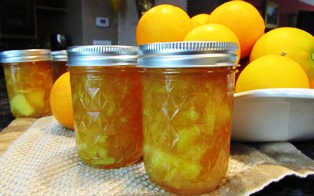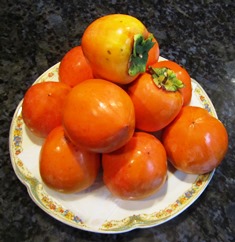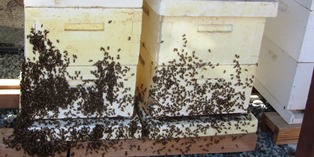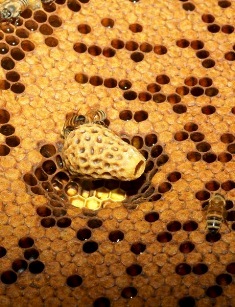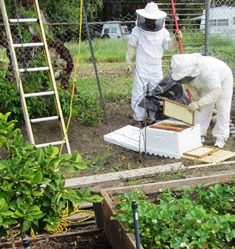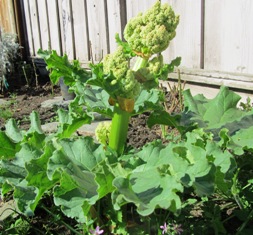Archive for April, 2014
Preserving Backyard Fruits and Vegetables
California urban farmers and backyard gardeners often find themselves with an abundance of leftover fruits and vegetables since California’s harvest season spans the whole year. What to do with all that produce?
Leftover produce can be donated to a food bank or preserved through various means, including boiling water canning, pressure cooker canning, freezing, or drying.
Canning supplies (and often, dehydrators) for preserving the bounty of fruits and vegetables are available year-round at local DIY stores, Walmart, K-Mart, Sears, kitchen and cooking supply outlets, hardware stores, and natural food markets as well as specialized container stores.

Strawberry jam, pictured here in a typical canning jar, tastes great on peanut butter sandwiches and toast
Boiling water canning (in which sealed jars are submerged in boiling water for a specific period of time) preserves high acid foods, including fruits, jams, jellies, tomatoes with added acid, pickles, applesauce, relishes, condiments, chutneys, sauces, fruit butters, sauerkraut, and vinegars.
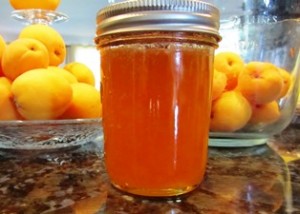
Apricots are easily turned into great-tasting jams and jellies in a boiling water bath canner or dried into leathers
The 212 degrees Fahrenheit of heat in boiling water coupled with the high acid content of the food prevents the growth of Clostridium botulinum, the organism that can cause botulism.
For preserving fresh garden vegetables, meat, seafood, and poultry (low acid foods), you’ll need to process these in a steam-pressure canner at a temperature of 240 degrees Fahrenheit for the established time (times are listed in many canning books and university websites for food preservation) to safeguard against Clostridium botulinum and other microbes. See, http://www.ag.ndsu.edu/pubs/yf/foods/fn173.pdf.
The U.S. Department of Agriculture (USDA) has produced a nifty home food preservation guide that is free and downloadable from http://nchfp.uga.edu/publications/publications_usda.html.
The National Center for Home Food Preservation (NCHFP) is a veritable treasure trove of information about how to safely preserve fruits, vegetables, seafood, and meat. The site also offers a self-study course and publications as well as many other resources. See http://nchfp.uga.edu/.
If you like dried fruit and fruit leathers, check out the NCHFP’s section on homemade fruit rolls (also known as leathers). See, http://nchfp.uga.edu/how/dry/fruit_leathers.html.
When you take the time to preserve the organic fruits and vegetables you grow and harvest, you can be sure of the quality and nutrient value of the food you and your family consume.
Swarming Season Has Arrived!
What’s not to love about spring? It’s only the middle of April and already we’ve seen several honeybee swarms. Swarming is how the bees reproduce their colonies and most often occurs during the warm days of early spring.
My neighbor, whom I’ve often called a world-class beekeeper (his father kept honeybees in Lebanon and taught him well) permitted me to keep his bee swarm that alighted in my apricot tree. He also generously donated a super (hive box) with some frames that already had wax, honey, and capped brood–all from his own apiary.
The newly housed honeybee workers delight in foraging on the various types of lavender (Spanish, English, and French perfume) that I’ve planted around the farmette. The colony will build up the wax and make honey while the nursemaid bees will care for the brood.
My husband, the architect-turned-farmer/beekeeper, has constructed a unique bee house for the hives. It will keep the bee boxes dry during winter rains and out of reach of marauding animals (skunks and raccoons). Resting on a platform that Carlos built on top of a newly installed brick floor, the hives are not within easy reach of the ever present ant population.
Alas, the bees weren’t about to wait until Carlos finished building their house. The swarm happened when the bees were ready to take flight (some 60 percent of the workers with their old queen) flew into our apricot tree.
If you see a swarm, call your local beekeeping association (or any store that carries local honey) for the name of a beekeeper. Avoid the temptation of spraying water or anything else on the swarm. Permit the beekeeper to safely remove the swarm.
For a beekeeper, rescuing a swarm is a truly exhilarating experience. Often a swarm consists of thousands to tens of thousands of honeybees. Beekeepers routinely rescue swarms from where bees have temporarily clustered while the bee scouts seek a permanent home. The beekeeper can shake them into a prepared hive box, leaving the box at the hive cluster site until all the bees are inside. At that point, the beekeeper takes the new hive to his apiary.
The beleaguered honeybees (whose populations have been decimated by the Varroa mite, weakened immune systems, and Colony Collapse Disorder) need help to survive and increase their populations. We need them, too! Without their pollination of fruit, nut, and other crops, our own food sources diminish.
Saving the honeybees is a good practice whenever possible because doing so ensures abundance and diversity in the plants we eat. Whenever I see a cluster of bees in a tree I feel joyful and celebratory. Is it any wonder that swarming season is my favorite time of the year?
Rhubarb–That “Pie Plant”
In my grandmother’s time, rhubarb’s moniker was the “pie plant” for the simple reason that the tart flavor of its canes nicely tempers the cloying sweetness of other fruits.
Rhubarb, long treated as a fruit, is actually a vegetable. In bygone days when tariffs on imported vegetables were higher than on fruit, a New York court decided in favor of labeling rhubarb as fruit for the purposes of taxation and tariff regulations.
One of the first edibles in the spring garden, rhubarb pushes up leaf stalks or canes (what botanists call petioles) with large leaves. The leaves are are high in oxalic acid and thus poisonous to consume (when harvesting, cut off the tops and discard; snap off the canes for cooking).
Rhubarb stalks or canes, when cooked with sugar or apples (to sweeten), are delicious in pies, jams, sauces and fruit tarts.
Rhubarb is easy to grow (in warm climates, it grows year-round). In cold climates, its leaves and canes will die but the rhizome root will generate new shoots come spring. But if it blooms, cut off the bloom to ensure the root continues to produce canes.
The plant can also be grown in large containers or in greenhouses. It is not fussy about soil, produces new canes year after year, and loves sunlight.
Consumers love those red canes, but rhubarb canes, depending on the variety, aren’t always red–some are light green or pink speckled. The flavor of the light green canes, the type growing on our farmette, has the most robust flavor.
While creating a space for some new plants, we decided to dig out one of our rhubarb plants. That little rhizome I put in the ground four years ago had produced roots 20 inches into the earth. Above ground the plant had grown roughly three feet high and as wide. We will divide it and replant, since it’s a good idea anyway to divide every 3 to 4 years.
We grow Victoria, an old variety with a tendency to flower (or bolt). We prefer to remove those flower spikes in order to keep the plant producing new canes and leaves. Blooms tend to waste the plants resources, see http://www.gardeningknowhow.com/edible/vegetables/rhubarb/rhubarb-bolting.htm. Also see, http://www.hort.purdue.edu/ext/rhubarbflowers.html
In an upcoming posting, I’ll include some recipes for using rhubarb from your garden. In the meantime, consider the different varieties available and perhaps try planting a new and different cultivar. See, http://www.rhubarbinfo.com/varieties.
 Facebook
Facebook Goodreads
Goodreads LinkedIn
LinkedIn Meera Lester
Meera Lester Twitter
Twitter





